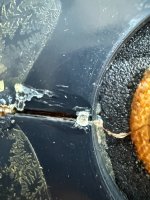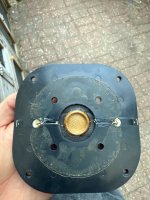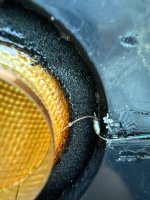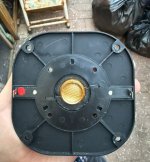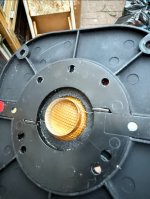Hi,
Thought out of anyone, folks here may be able to help with this.
Basically, I have these old KRK monitors, the 9000bs, which I've been using for years for my music production. They're widely considered some of the best monitors around, and what I feared would happen has. I have a pair and a spare, but in both one of the ones in use and the spare, the tweeters have randomly stopped working.
It is extremely difficult to get a replacement. Focal made replacements for a while, but these have also become very rare.
So the bottom line is that I'm out of luck. However, I'm also not entirely sure what's wrong with them. People go straight to trying to source a replacement when a tweeter 'blows', but I was wondering if there's a way to trouble shoot what's actually gone wrong with them, and possibly to repair them?
I have managed to locate this spec sheet for the tweeter: http://www.acoustica.org.uk/impulse/images/TC90K.PDF
I should also add that it presumably isn't the crossover and is the tweeter, because I swapped the faulty one(s) to the other cabinet, and the problem followed.
Any advice would be much appreciated. Thanks!
Thought out of anyone, folks here may be able to help with this.
Basically, I have these old KRK monitors, the 9000bs, which I've been using for years for my music production. They're widely considered some of the best monitors around, and what I feared would happen has. I have a pair and a spare, but in both one of the ones in use and the spare, the tweeters have randomly stopped working.
It is extremely difficult to get a replacement. Focal made replacements for a while, but these have also become very rare.
So the bottom line is that I'm out of luck. However, I'm also not entirely sure what's wrong with them. People go straight to trying to source a replacement when a tweeter 'blows', but I was wondering if there's a way to trouble shoot what's actually gone wrong with them, and possibly to repair them?
I have managed to locate this spec sheet for the tweeter: http://www.acoustica.org.uk/impulse/images/TC90K.PDF
I should also add that it presumably isn't the crossover and is the tweeter, because I swapped the faulty one(s) to the other cabinet, and the problem followed.
Any advice would be much appreciated. Thanks!
Absolutely a blown tweeter can often be repaired. I've done it many, many times. Everything from Yamaha NS-1000M beryllium tweeters to random Wharfedale domes.
Unless you have a long-term thermal failure (too much power on a consistent basis which truly 'cooks' a VC), tweeters usually fail for transient events, where the lead-in wire vaporizes leaving the VC (voice coil) intact. Such failures can be repaired with a bit of microsurgery- either unwinding one turn or carefully re-attaching and soldering a new lead-in wire.
Unless you have a long-term thermal failure (too much power on a consistent basis which truly 'cooks' a VC), tweeters usually fail for transient events, where the lead-in wire vaporizes leaving the VC (voice coil) intact. Such failures can be repaired with a bit of microsurgery- either unwinding one turn or carefully re-attaching and soldering a new lead-in wire.
Thanks for the reply.check for continuity, around 6 ohms.
remove 4 screws holding faceplate to magnet, then inspect tags, voicecoil etc.
post pictues.
I've ordered a multimeter. In the meantime, here are some pictures. Having taken a look, the one that's not working seems to be missing a plastic plate that goes over the wires compared to the working one, and it also appears to have already been repaired in the past.
As I say, there is also a spare with a tweeter that isn't working; I can't currently get the screws off of that one because two of them have stripped, so will have to find a work around.
Attachments
Absolutely a blown tweeter can often be repaired. I've done it many, many times. Everything from Yamaha NS-1000M beryllium tweeters to random Wharfedale domes.
Unless you have a long-term thermal failure (too much power on a consistent basis which truly 'cooks' a VC), tweeters usually fail for transient events, where the lead-in wire vaporizes leaving the VC (voice coil) intact. Such failures can be repaired with a bit of microsurgery- either unwinding one turn or carefully re-attaching and soldering a new lead-in wire.
Good to hear! Have posted some pictures above.
I have actually managed to find a couple of suppliers for new voice coils for these models. After-market ones, but they're apparently near identical. If I can't repair mine, would I notice the sound difference between the original coil and a new one do you think? Thanks.
I have now tested both the working tweeter and the broken one with a multimeter. Working one was around 6 ohms, the not working one displayed no number on the screen, just OL.
Exactly as you would expect. That reading (OL=over limit) means that there is an open that you must find to repair. For me, this is surgical stuff but with care, can be done. You have nothing to lose, I'd say. You might even try probing in a few spots around those lead in wires with a toothpick and see if you get lucky. Magnifiers help me a lot with such stuff, and of course great lighting.
Understood, thanks.
When you say probing around the lead in wires, what do you mean by that? What would I be hoping to find?
When you say probing around the lead in wires, what do you mean by that? What would I be hoping to find?
I'm pretty sure Focal still repairs these TC90Ks, but you'd have to contact them to find out for sure. The surrounds love to disintegrate on these tweeters. That's another issue to expect.
It would be wise trying to find a used donor so you have something to fall back on. Just make sure the flat surround is in good shape and doesn't sit tilted in the gap. This is another common failure on these tweeters.
Doing this type of surgery on any tweeter isn't for the inexperienced. The VC gap is very tight on these things. You have to get the dome placement just right in terms of height and radial center. Making sure the VC isn't out of round is yet another challenge if you decide to only replace the VC itself.
I managed to repair a TC120K for someone by making a fixture that locates the VC accurately for somewhat of a guaranteed outcome.
It would be wise trying to find a used donor so you have something to fall back on. Just make sure the flat surround is in good shape and doesn't sit tilted in the gap. This is another common failure on these tweeters.
Doing this type of surgery on any tweeter isn't for the inexperienced. The VC gap is very tight on these things. You have to get the dome placement just right in terms of height and radial center. Making sure the VC isn't out of round is yet another challenge if you decide to only replace the VC itself.
I managed to repair a TC120K for someone by making a fixture that locates the VC accurately for somewhat of a guaranteed outcome.
I recently repaired a tweeter from a vintage KLH Model 6 that produced no sound yet measured close to 900ohms. Intrigued, I pried away the protective screen to examine the lead-in wires and found an attachment point that had annealed or carbonized producing the high resistance. It looked very much like instance in picture 3 above....the blackening under the adhesive that secures the wire. This may be where the open is, and not the VC. I was able to affect a repair through cutting the wire on either side of the damage and splicing them together. No idea what kind of power it can handle but at least it's working again.
It might be worthwhile to check the continuity on either side of these points by gently scraping away a bit of the enamel and measuring before giving up on them.
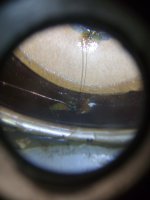
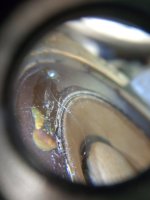
It might be worthwhile to check the continuity on either side of these points by gently scraping away a bit of the enamel and measuring before giving up on them.


I'm pretty sure Focal still repairs these TC90Ks, but you'd have to contact them to find out for sure. The surrounds love to disintegrate on these tweeters. That's another issue to expect.
It would be wise trying to find a used donor so you have something to fall back on. Just make sure the flat surround is in good shape and doesn't sit tilted in the gap. This is another common failure on these tweeters.
Doing this type of surgery on any tweeter isn't for the inexperienced. The VC gap is very tight on these things. You have to get the dome placement just right in terms of height and radial center. Making sure the VC isn't out of round is yet another challenge if you decide to only replace the VC itself.
I managed to repair a TC120K for someone by making a fixture that locates the VC accurately for somewhat of a guaranteed outcome.
Thanks for the reply, lucky to find someone who has actually worked on these before.I'm pretty sure Focal still repairs these TC90Ks, but you'd have to contact them to find out for sure. The surrounds love to disintegrate on these tweeters. That's another issue to expect.
I'll definitely send Focal an email -- I know they were replacing them years ago but have since stopped, but perhaps repairs are still an option.
I managed to repair a TC120K for someone by making a fixture that locates the VC accurately for somewhat of a guaranteed outcome.
I think these are the TC120Ks rather than the TC90Ks. I believe the latter were used in the 7000bs and the former my 9000bs, but correct me if I'm wrong? There also seems to be a fair bit of confusion surrounding original vs Focal tweeters in these monitors. From my understanding, all the ones I've ever seen have been Focal ones, so no idea what the original KRK ones are like. And then I've also seen variants of these with a black cone and extra protrusion in the middle.
It would be wise trying to find a used donor so you have something to fall back on. Just make sure the flat surround is in good shape and doesn't sit tilted in the gap. This is another common failure on these tweeters.
Potential donors pop up from time to time. There's one on eBay at the moment: someone selling two cabinets, one with a tweeter that isn't working, and that's my issue with buying donors. Given that someone else is selling a pair with a dead tweeter, and I have two the same (one of which wasn't even in use when it randomly stopped working), I just feel like I'm going to spend all that money on old parts and the same thing happen a year or so down the road.
Regarding the 'flat sorround', are you refering to the foam insert rings around the cone? These parts seem to be quite readily available.
Doing this type of surgery on any tweeter isn't for the inexperienced. The VC gap is very tight on these things. You have to get the dome placement just right in terms of height and radial center. Making sure the VC isn't out of round is yet another challenge if you decide to only replace the VC itself.
Well, I'm inexperienced, but willing to learn, and as another user pointer out, if it's already dead I don't really have anything to lose. Could you explain to me this fixture you designed?
Thanks!
This is interesting, thanks!I recently repaired a tweeter from a vintage KLH Model 6 that produced no sound yet measured close to 900ohms. Intrigued, I pried away the protective screen to examine the lead-in wires and found an attachment point that had annealed or carbonized producing the high resistance. It looked very much like instance in picture 3 above....the blackening under the adhesive that secures the wire. This may be where the open is, and not the VC. I was able to affect a repair through cutting the wire on either side of the damage and splicing them together. No idea what kind of power it can handle but at least it's working again.
It might be worthwhile to check the continuity on either side of these points by gently scraping away a bit of the enamel and measuring before giving up on them.
View attachment 1460306View attachment 1460307
Can you explain again where I should be testing continuity? Which part of the enamel should I be scraping away? Do you mean within the valley leading to the connectors?
- Home
- Design & Build
- Electronic Design
- Can a 'blown' tweeter be repaired?
